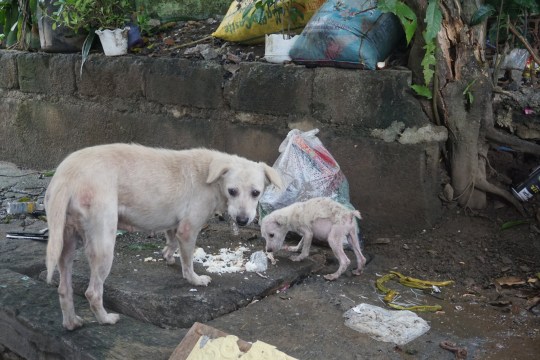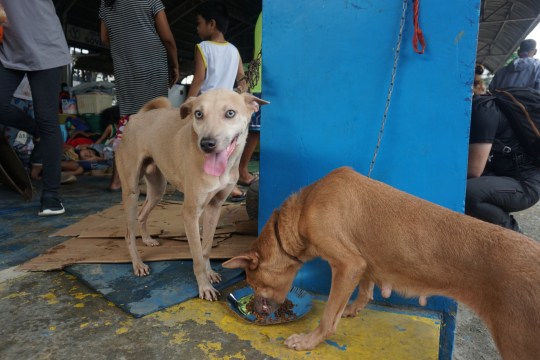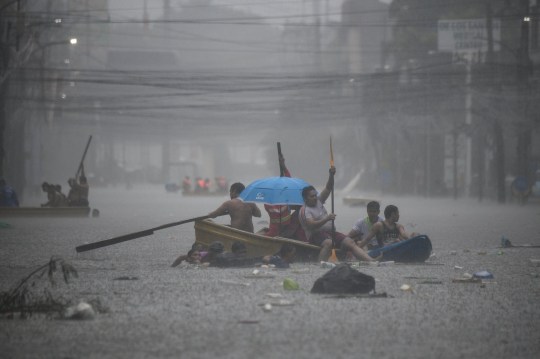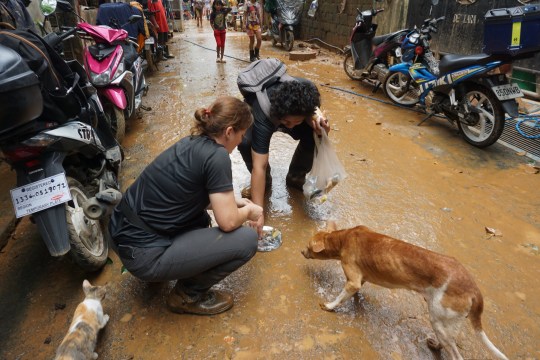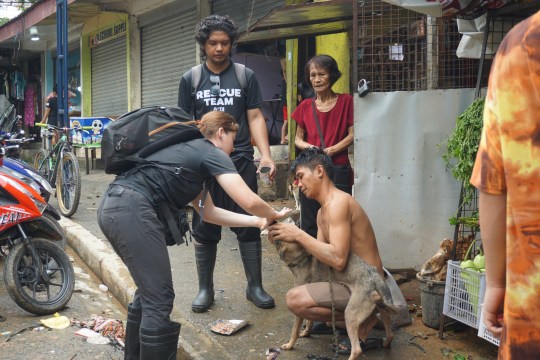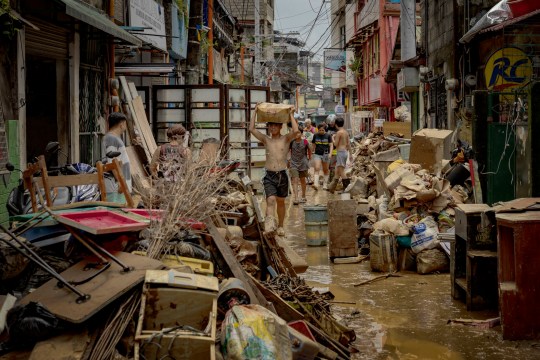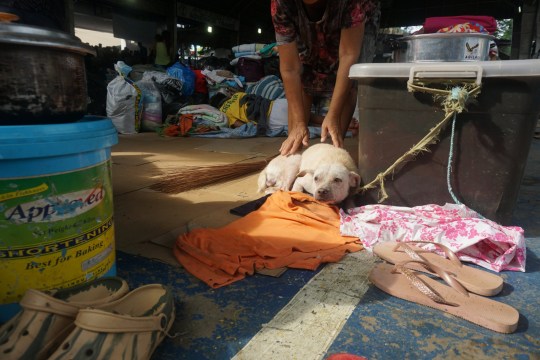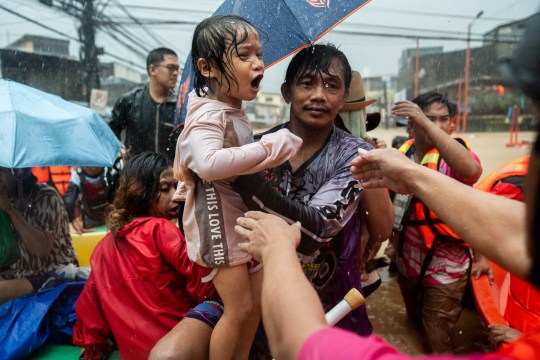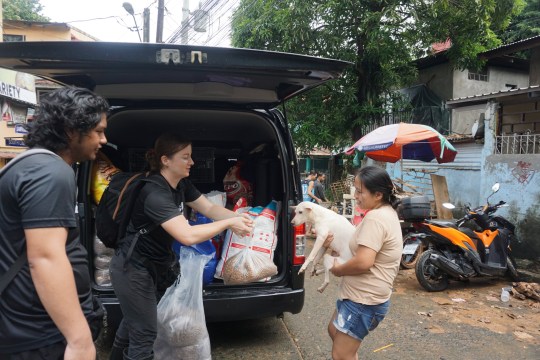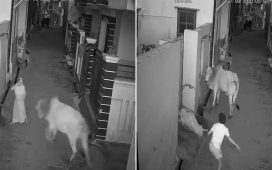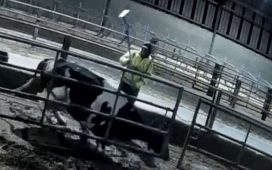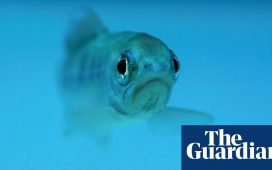Even after their owner’s homes were destroyed by the floods, the dogs Ashley Fruono found were still chained to lamposts or in cages outside.
Typhoon Gaemi, one of the most powerful storms to hit southeast Asia in years, thrashed the Philippines in July. Dozens died and tens of thousands had to be evacuated as Gaemi churned powerful winds and dumped heavy rains – countless dogs, however, were left behind.
‘I’ll never forget seeing the decomposing bodies of dogs in cages or attached to their chains with a look of horror on their faces,’ Ashley, PETA Asia’s director of animal assistance programmes, tells Metro.co.uk.
‘They were subjected to an almost unimaginably horrific death – that was completely preventable.’
Animal abuse has long been a major concern for animal rights activists in the Philippines, which is home to some 23.29 million dogs. Around 12,000,000 people own a dog, according to the worldwide kennel club registry, the Federation Cynologique Internationale.
Yet there were at least 3,000 cases of animal maltreatment in 2020 alone, the Philipino animal welfare non-profit, Compassion and Responsibility for Animals (CARA), found.
‘Cruelty to animals is a huge concern in the Philippines,’ Ashley, 38, who is from British Columbia, Canada, but has lived in the Philippines for 17 years, says.
Think of dogs caged up or chained to lamposts, utility poles or wooden beams outside their owner’s house, forced to eat, sleep, and relieve themselves on the same patch of dirt for days on end.
‘While we’ve noticed that, thanks to increased social media use, locals are more aware of animal welfare concerns and more caring than a decade or so ago, the problem is still huge, especially in impoverished areas where it may be more difficult to keep dogs inside due to crowded living conditions,’ Ashley says.
Beating, torturing, or killing animals other than livestock is illegal in the Philippines. If the animal dies, an abuser can be jailed for up to two years and fined ₱100,000, about £1,300.
One instance that sticks out in Ashley’s mind is Nova. The Aspins dog was found by rescuers tethered outside in Quezon City, a densely populated suburb northeast of the capital, Manila, in May. Her owner had refused to bring her inside – she wasn’t even fed daily.
Nova, Ashley says, ‘had only a small, dilapidated wooden box to shelter her from the blazing heat and torrential rain – and she was desperate for affection’.
After being treated by a vet, Nova was rehomed through PETA’s Ampon Alaga programme, says Ross Rowalle, a senior cruelty caseworker at PETA Asia.
‘Nova has now found a loving home but many other dogs like her are still suffering out of sight, chained up and denied any semblance of care or comfort,’ he adds.
For dogs like Nova, chained and caged, they had only a slim chance of surviving when Gaemi arrived.
Gaemi, known in the Philippines as Carina, left a trail of destruction in the Philippines that killed 48 people. The storm intensified the country’s already heavy monsoon rains, leaving parts flooded and buried by landslides.
More than 6,220,000 people were impacted by Gaemi and the monsoons, the Philippines National Disaster Risk Reduction and Management Council estimated.
Dogs, too. ‘It might come as a surprise, but it actually had the greatest impact on dogs who have owners,’ Ashley says.
‘Animals are family members who shouldn’t be left alone in chains or in cages.
‘Not only does it make their life frustrating and lonely, it can also spell a terrifying death should natural disaster strike, as they’re unable to escape.’
The supercharged southwest monsoon, locally known as ‘habagat’, lashed the Philippines for days and, at one point, bucketed 2000mm of rain on the capital in 24 hours.
Rescuers trudged through nearly neck-deep floodwater to save survivors clinging onto power lines and used shopping trolleys to get around.
Many Filipinos were packed into evacuation centres inside school gymnasiums, churches and health centres during this time. But a years-long issue for animal rescue fieldworkers has been relief centres not allowing pets and strays inside over hygiene and space, forcing owners to make difficult decisions about their animal companion’s lives.
‘Thankfully, this is gradually changing. During super typhoon Gaemi, we did see more and more evacuation centres – and even some government rescue boats – accepting animals,’ Ashley explains. ‘This hasn’t been the case in previous years, so it’s a promising change.’
While pet owners are advised to transport their pets in a carrier – or repurpose a laundry basket – unchaining pets is considered a last resort.
These animals may never be seen again, Ashley says,
Animal fieldworkers, working on tight budgets and next to no resources, have described the aftermath of the typhoon for critters as haunting. Photographs shared by the Metro Manila Disaster Risk Reduction and Management Council, which PETA Asia awarded a Hero to Animals Award, show rescuers wading through filthy to save abandoned dogs.
Starved and dehydrated, some were found suffering from diseases.
One such pup was Carina. Riddled with worms and mange, an itchy skin disease caused by parasitic mites, she was found by a family sheltering inside the second story of their home.
‘Carina is now on the road to recovery in foster care, awaiting a permanent, loving home,’ Ashley recalls.
‘Carina’s entire life has changed since we found her.’
Get in touch with our news team by emailing us at webnews@metro.co.uk.
For more stories like this, check our news page.
MORE : The vet’s words about Dudley ripped my heart out of my chest
MORE : ‘Cremated’ cat, Ted, saunters back home four days after dying
MORE : Swans stoned to death after children seen ‘pelting them’ in park
Get your need-to-know
latest news, feel-good stories, analysis and more
This site is protected by reCAPTCHA and the Google Privacy Policy and Terms of Service apply.
